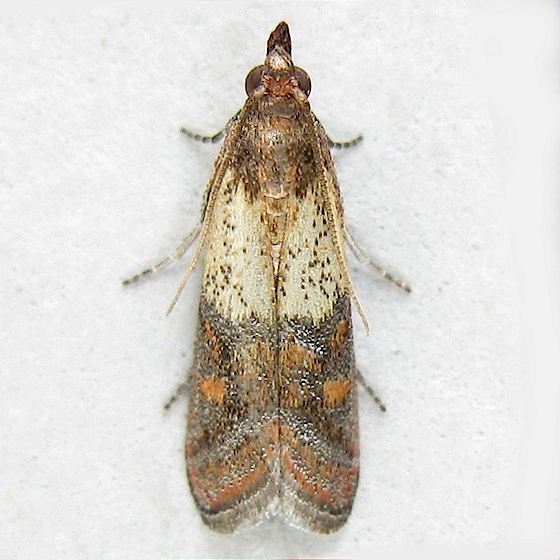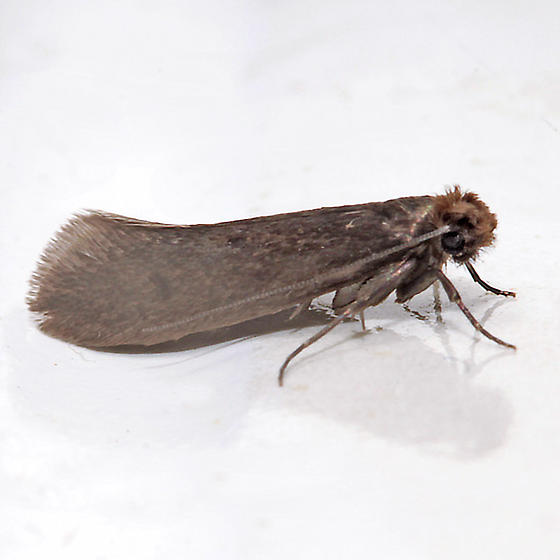
INDIAN MEAL MOTH
Common Name: Moth – Indian meal moth
Latin Name: Plodia interpunctella
Common Family Name: Pyralid moths
Latin Family Name: Pyralidae
Other Names:
Origin: A native of Europe and Asia, but now found throughout the world. The common name was given to the moth by an American entomologist who found it infesting cornmeal, or “Indian” corn.
Biology: This moth species can be found infesting possibly the widest range of food products of any moth, from nuts to grain products to fresh or dried fruit. It will infest virtually any processed food of vegetable origin, including candy bars, pet foods, and spices. It infests seeds and commonly will be in dried flower arrangements. It is a major pest of commercial dried fruit and nut industries. Females can lay up to 400 eggs on the food material, over a 2 to 3-week period, usually at night. Adult moths tend to avoid lights. The larvae feed in seclusion, spinning silk webbing over themselves and the food material as they feed and move about. The period from egg to adult can be less than one month or up to almost a year, depending primarily on temperature and humidity. Under favorable conditions, there can be as many as 8 generations per year. The larvae typically leave the infested food and wander long distances to seek a protected spot to pupate, and their thin silk cocoons can be found in rooms far away from the infested material.
Identification: The adult moth is very distinctive, with a coppery red outer half to each forewing, and a creamy white basal half. They are small moths with a wingspan of only about 20 mm or less. The larvae are small and typically Lepidoptera, with their color ranging from tan to white to pink to even a greenish tint. The larva has no spots along its body, distinguishing it from similar food pest moth species.
Characteristics Important in Control: Typical of most stored food moth infestations, an inspection must be made to determine which materials are infested, including areas of the structure where foods may not typically be found, such as garages or closets. Disposal of the infested material, followed by a thorough cleaning of the area and possible application of a residual insecticide to intercept any larvae that may have left the food material is needed. Special consideration must be made to unusual possibilities such as dried flowers, and also to the discovery and removal of larvae and pupae some distance from the infested materials.

CLOTHES MOTH
Common Name: Moth – Case-making clothes moth
Latin Name: Tinea pellionella
Common Family Name: Tineid moths
Latin Family Name: Tineidae
Origin: Possibly Asian in origin, but found throughout the world.
Biology: The larvae are most damaging to fabrics of animal hair origin, but also may infest spices or grain-based foods, tobacco, feathers, dead insects, and fungus accumulations. A related species may often be found feeding on the mycelial growth of fungus on damp wood. The larvae create a silken case which they must stay within, dragging it with them as they move about, and enlarging it as they grow. The adults do not feed, and both adults and larvae avoid light, although the larvae may wander over walls and floors in a darkened room.
Identification: The larva is easily identified by the small, tubular silk case it creates. This case will be the color of the material it feeds on, as it incorporates fibers from the material into the case. The adults are tiny moths, with long, narrow wings that are grayish-brown in color. There is a fringe of long hairs along the lower edge of the hind wing, and on fresh specimens, there will be 3 dark spots on the forewings. On the top of the head, there is a tuft of yellowish hairs.
Characteristics Important in Control: Seeking the source of the infestation is crucial, as killing only adult moths does not affect the developing larvae. The larval habitat will be in a hidden area, usually in materials that have remained undisturbed for some period of time, and alternative foods such as insect nests or fungus growth need to be considered.